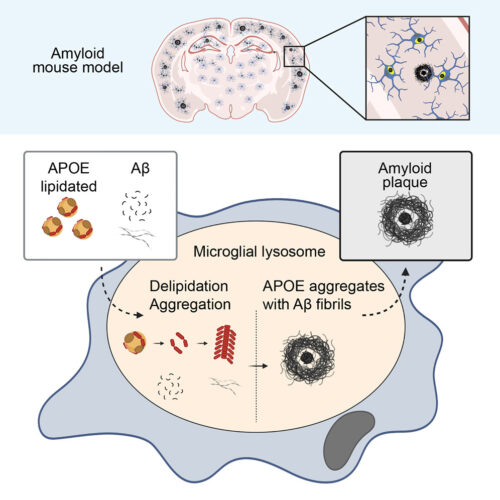APOE aggregation in microglia initiates Alzheimer’s disease pathology by seeding β-amyloidosis
Other (17)
Background:
Alzheimer’s disease (AD) is characterized by the accumulation of amyloid-β (Aβ) plaques in the brain, contributing to neurodegeneration. The process by which these plaques form, particularly in sporadic (non-familial) cases of AD, remains not fully understood. Genetic studies have linked the apolipoprotein E (APOE) gene and microglial function—immune cells in the brain—to AD, suggesting their involvement in disease initiation.
Key Findings:
- APOE Aggregation:
- Researchers developed a transgenic mouse model expressing a tagged version of the APOE protein (APOE-HaloTag) to study its behavior in the brain.
- They discovered that APOE can form fibrillar aggregates—structures associated with misfolded proteins—in both these mice and human AD brain samples.
- Microglial Involvement:
- These APOE aggregates were found within microglia, the brain’s resident immune cells.
- The presence of APOE aggregates in microglia was associated with the initiation of Aβ plaque formation, suggesting a seeding mechanism where APOE aggregates promote Aβ accumulation.
- Mechanistic Insights:
- The study identified that the aggregation of APOE within microglia triggers Aβ amyloidosis through the endo-lysosomal system—a cellular pathway involved in processing and degrading cellular components.
- This process is influenced by microglial lipid metabolism and the JAK/STAT signaling pathway, both crucial for microglial function and response to pathological changes.
Implications:
The findings propose a novel mechanism for the onset of Aβ plaque formation in sporadic AD:
- Initiation of Aβ Plaques:
- APOE aggregates within microglia act as seeds, initiating the aggregation of Aβ, leading to plaque formation.
- Therapeutic Targets:
- Targeting APOE aggregation, modulating microglial lipid metabolism, or influencing the JAK/STAT pathway could offer new therapeutic strategies for preventing or slowing the progression of AD.
Conclusion:
This study highlights the pivotal role of APOE aggregation within microglia in initiating Aβ plaque formation, offering fresh insights into the early events of Alzheimer’s disease pathology. These discoveries open new avenues for research and potential therapeutic interventions targeting microglial processes and APOE aggregation to combat AD.
For a comprehensive understanding, you can access the full article here: Apolipoprotein E aggregation in microglia initiates Alzheimer’s disease pathology by seeding β-amyloidosis.





